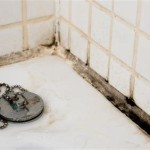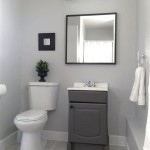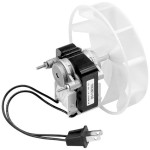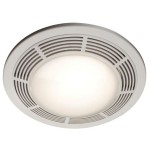Bathroom Exhaust Fan 150 CFM: A Comprehensive Guide
Bathroom exhaust fans are essential components of a healthy and comfortable home. They play a critical role in removing moisture, odors, and pollutants from the bathroom, thereby preventing mold growth, protecting building materials, and improving indoor air quality. The selection of an appropriately sized exhaust fan is paramount to ensure effective performance. A 150 CFM (cubic feet per minute) bathroom exhaust fan represents a specific airflow capacity suitable for bathrooms of a certain size and usage level. This article provides a comprehensive overview of 150 CFM bathroom exhaust fans, covering their application, selection criteria, installation considerations, and maintenance requirements.
Understanding CFM and Bathroom Size
CFM is a unit of measurement that indicates the volume of air an exhaust fan can move in one minute. A higher CFM rating signifies a greater airflow capacity. Determining the appropriate CFM for a bathroom involves considering the bathroom's square footage. A common rule of thumb suggests that a bathroom exhaust fan should have at least 1 CFM for every square foot of bathroom area. Therefore, a 150 CFM exhaust fan is generally suitable for bathrooms up to 150 square feet. For bathrooms larger than 150 square feet, a fan with a higher CFM rating may be necessary.
However, the square footage rule is a simplified guideline. Other factors can influence the required CFM. For example, bathrooms with high ceilings, frequently used showers or tubs, or multiple occupants may require a higher CFM rating than what the square footage calculation suggests. Consulting with a qualified HVAC professional is recommended to determine the optimal CFM for the specific bathroom conditions.
In addition to square footage, consider the height of the bathroom ceiling. Bathrooms with ceilings higher than the standard 8 feet require additional CFM to effectively remove moisture. For each foot above 8 feet, an additional 20% CFM may be needed. Therefore, a 150 CFM fan in a bathroom with a 10-foot ceiling may not provide adequate ventilation, and a larger CFM fan should be considered.
The frequency of bathroom usage and the type of fixtures also play a significant role. A bathroom used heavily for showering or bathing will generate more moisture than a guest bathroom used infrequently. Similarly, whirlpool tubs and steam showers produce significantly more moisture than standard showers and require more powerful exhaust fans to prevent moisture buildup. In such scenarios, a fan with a higher CFM rating, such as a 200 CFM or greater, may be more appropriate.
Key Features and Selection Criteria
Selecting a 150 CFM bathroom exhaust fan involves evaluating several key features and factors beyond just the CFM rating. Sound level, energy efficiency, lighting features, and control options are all important considerations. Understanding these features ensures the selection of a fan that meets the specific needs and preferences.
Sound Level (Sones): Bathroom exhaust fans produce noise during operation. The sound level is measured in sones, with a lower sone rating indicating a quieter fan. A 150 CFM exhaust fan typically ranges from 0.5 sones to 3.0 sones. For bedrooms or bathrooms located near living areas, a fan with a lower sone rating is preferred to minimize noise disturbance. A sone rating of 1.0 or less is generally considered very quiet, while a rating above 2.0 may be noticeable and potentially disruptive. Manufacturers often specify the sone level in the product specifications, and it's essential to review this information before making a purchase.
Energy Efficiency: Bathroom exhaust fans consume energy, and selecting an energy-efficient model can reduce energy bills and minimize environmental impact. Look for Energy Star certified fans, which meet specific energy efficiency standards set by the Environmental Protection Agency (EPA). Energy Star certified fans typically use less energy and operate more quietly than standard models. They often incorporate features such as electronically commutated motors (ECMs) and more efficient fan blades, resulting in reduced energy consumption without compromising performance. The energy efficiency of a fan is typically indicated by its airflow efficiency rating, measured in CFM per watt. A higher CFM per watt rating signifies greater energy efficiency.
Lighting Features: Many bathroom exhaust fans incorporate lighting features, such as incandescent bulbs, halogen bulbs, or LED lights. These integrated lights can provide additional illumination in the bathroom and eliminate the need for a separate light fixture. LED lights are generally preferred for their energy efficiency, long lifespan, and bright, even illumination. Some fans also offer dimming capabilities, allowing users to adjust the light level to their preference. When selecting a fan with lighting features, consider the type of bulb, wattage, and light output (lumens) to ensure that the lighting adequately meets the bathroom's illumination needs.
Control Options: Bathroom exhaust fans can be controlled manually with a simple on/off switch or automatically with a timer or humidity sensor. Timer controls allow the fan to run for a pre-set duration, ensuring that moisture is removed even after the user leaves the bathroom. Humidity sensors automatically activate the fan when humidity levels exceed a certain threshold, preventing mold growth and maintaining indoor air quality. Some advanced models offer smart controls with Wi-Fi connectivity, allowing users to remotely control the fan using a smartphone or tablet. Consider the control options that best suit the lifestyle and preferences.
Installation Considerations: The ease of installation is another important factor to consider and can be broadly categorized by whether the fan is a replacement or a new installation. Replacing an existing fan typically involves removing the old fan and installing the new one in its place. New installations, on the other hand, require running new ductwork and wiring, which can be more complex and time-consuming. Consider the skill level and experience when deciding whether to install the fan or hire a professional electrician or HVAC technician. Ensure the fan is compatible with the existing ductwork size and configuration. Smaller ductwork can restrict airflow and reduce the fan's effectiveness. If the existing ductwork is undersized, it may need to be replaced or upgraded.
Installation and Maintenance
Proper installation and regular maintenance are crucial for ensuring the optimal performance and longevity of a 150 CFM bathroom exhaust fan. Incorrect installation can lead to reduced airflow, increased noise levels, and potential fire hazards. Regular maintenance, such as cleaning the fan blades and motor, prevents dust and debris buildup, which can impede airflow and reduce the fan's efficiency.
Installation Guidelines: Before installing a bathroom exhaust fan, carefully review the manufacturer's instructions and safety guidelines. Disconnect the power supply to the bathroom circuit breaker to prevent electrical shock. Ensure that the fan is properly grounded according to local electrical codes. The fan should be vented to the outside through a dedicated duct, ideally with a smooth, rigid ductwork. Flexible ductwork can restrict airflow and should be avoided wherever possible. The ductwork should be insulated to prevent condensation and moisture buildup. The exhaust vent should be located on the exterior of the building, away from windows, doors, and air intakes. Avoid routing the vent into the attic or crawl space, as this can lead to moisture problems and mold growth.
DIY vs. Professional Installation: While some homeowners may be comfortable installing a bathroom exhaust fan themselves, others may prefer to hire a professional electrician or HVAC technician. If unfamiliar with electrical wiring or ductwork, it is recommended to seek professional assistance. A qualified professional can ensure that the fan is installed correctly and safely, according to local building codes. Professional installation may also be required to maintain the fan's warranty. Hiring a professional can save time and effort and provide peace of mind knowing that the installation is done correctly.
Maintenance Procedures: Regular maintenance is essential for maintaining the fan's performance and extending its lifespan. Dust and debris can accumulate on the fan blades and motor, reducing airflow and increasing noise levels. At least once a year, or more frequently if necessary, clean the fan blades and motor. Disconnect the power supply to the fan before performing any maintenance. Remove the fan cover and carefully clean the fan blades using a soft brush or vacuum cleaner attachment. Wipe down the motor housing with a damp cloth. Avoid using harsh chemicals or abrasive cleaners, as they can damage the fan components. Check the ductwork for any obstructions or damage and repair as needed. Lubricate the motor bearings periodically, according to the manufacturer's instructions. Replace the fan cover and reconnect the power supply.
Troubleshooting Common Issues: Several common issues can arise with bathroom exhaust fans, such as reduced airflow, excessive noise, or failure to operate. Reduced airflow can be caused by clogged ductwork, dirty fan blades, or a faulty motor. Excessive noise can be caused by loose fan blades, worn bearings, or a damaged motor. If the fan fails to operate, check the circuit breaker, wiring connections, and motor. Consult the manufacturer's troubleshooting guide for specific instructions on diagnosing and resolving common issues. If unable to resolve the issue, contact a qualified electrician or HVAC technician for assistance.
In conclusion, a 150 CFM bathroom exhaust fan is a vital component for maintaining a healthy and comfortable bathroom environment. Understanding the factors that influence CFM requirements, selecting a fan with the appropriate features, and performing regular maintenance are essential for ensuring optimal performance and longevity. Careful planning and execution of these considerations will result in improved air quality, prevention of moisture-related problems, and creation of a more pleasant bathroom experience.

Air King Ak150ls 150 Cfm Quiet Bathroom Exhaust Fan Ceiling Mount 6 Inch Duct

Ef Az104wh Azi Broad Series 150 Cfm Ceiling Mount Bathroom Exhaust Fan With Brilliant Led Light

Fantech Pro 150 Cfm Bathroom Exhaust Fan Surface Mount 6 Inch Oval Duct

Ceiling Mount Bathroom Exhaust Fan 150 Cfm Made In Com

Ef Az105wh Azi Fields Series 150 Cfm Ceiling Mount Bathroom Exhaust Fan With Brilliant Led Light

Continental Fan Tf150 Tf Tranquil Bathroom 150 Cfm 6 Inch Duct

Smt150led 150 Cfm Exhaust Fan Led Light Night Delta Breezsmart

Usp Energy Star Qualified Bath Exhaust Fan 150 Cfm Bf 1506uq

Panasonic Ventilation Fv 11 15vk1 Sc Whispergreen Select 150 Cfm Bathroom Exhaust Fan Ceiling Mount 6 Inch Duct Sd Control

Broan Evolve Premium 110 130 150 Cfm Bathroom Exhaust Fan Sylvane







